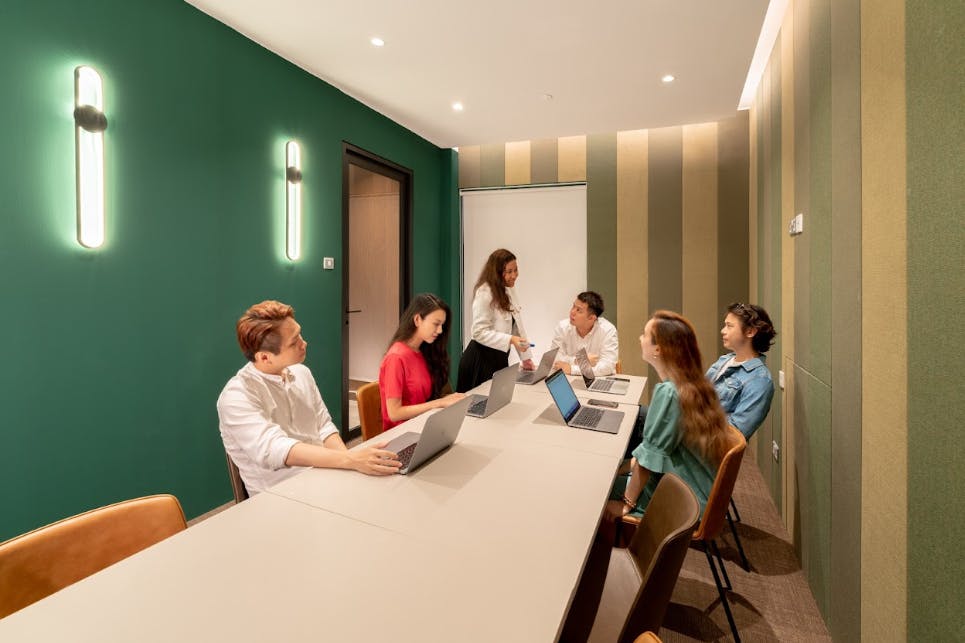Workspace flexibility revolutionizes modern work, adapting to diverse workforce needs with remote and hybrid models. This transformation aims to enhance productivity and satisfaction while addressing organizational challenges.
Let's explore how it affects remote and hybrid work environments and what's key for success!
Trends Shaping Workspace Flexibility
Image courtesy: Pexels
The work landscape is changing drastically, driven by emerging trends. These shifts are reshaping not only our work locations but also how we approach tasks and collaboration, fostering dynamism and adaptability.
Rise of Remote Work
One of the most significant trends shaping workspace flexibility is the rise of remote work. Fueled by technological advancements and catalyzed by global events such as the COVID-19 pandemic, businesses and employees alike have discovered the feasibility and benefits of working from locations outside the traditional office. This shift represents not just a temporary adjustment but a fundamental reevaluation of the necessity of physical presence for productivity and company culture. As high-speed internet and collaboration tools become even more widely accessible, the trend towards remote work shows no sign of slowing down.
Adoption of Hybrid Work Model
The rise of remote work has spurred the adoption of the hybrid work model, blending the flexibility of remote work with the collaboration of office settings. Employers offer this option to let employees split their time between home and office as needed, enhancing effectiveness and job satisfaction through location flexibility.
Discover the expansive network of coworking spaces at Staytion, proud to be Southeast Asia's largest. Whether you're seeking vibrant workspaces, state-of-the-art facilities, or a supportive community, our diverse range has something for everyone.
Explore the possibilities at www.gostaytion.com and find the perfect space to elevate your work experience today!
Benefits of Workspace Flexibility
The transformation towards more flexible workspaces comes with a host of benefits for both employees and employers, driving further the adoption of these new models.
Improved Work-Life Balance
One of the most immediate benefits of workspace flexibility is an improved work-life balance. The ability to work remotely or adopt a hybrid schedule allows individuals to better integrate their professional and personal lives, reducing commute times and providing greater control over their schedules. This flexibility can lead to a healthier lifestyle, with more time for exercise, hobbies, and family, contributing to greater overall well-being.
Increased Productivity
Contrary to initial concerns, workspace flexibility often results in increased productivity. Freed from the confines of a traditional office and rigid schedule, many employees find that they can work more efficiently, focusing on outputs rather than hours spent at a desk. The ability to work during times of peak personal productivity, without the distractions of a busy office, can lead to higher quality work completed in less time.
Enhanced Employee Satisfaction
Finally, workspace flexibility contributes to enhanced employee satisfaction. This comes not only from the improved work-life balance and increased productivity but also from a sense of autonomy and trust. When employers offer flexible working options, they are essentially showing faith in their employees' ability to manage their time and tasks effectively. This trust builds a more positive employer-employee relationship, reducing turnover rates and fostering a more engaged and committed workforce.
Challenges to Overcome
Image courtesy: Unsplash
Communication Issues
Remote and hybrid models can lead to communication inefficiencies, causing misunderstandings and project delays. To address this, companies must implement robust digital tools and clear communication guidelines.
Solution: In response to the challenges posed by remote and hybrid work models, companies can implement robust digital communication tools and establish clear guidelines for effective communication. By leveraging platforms like Microsoft Teams or Slack, teams can collaborate in real-time, minimizing misunderstandings and streamlining project workflows.
Maintaining Company Culture
With dispersed teams, sustaining a cohesive company culture becomes challenging. Activities promoting team bonding and alignment with company values are essential but harder to organize.
Solution: Maintaining a strong company culture amidst dispersed teams requires proactive measures. Companies can organize virtual team-building activities, regular town hall meetings, and recognition programs to foster a sense of belonging and alignment with company values. By prioritizing these initiatives, organizations can uphold their culture even in a remote or hybrid work environment.
Performance Measurement
Evaluating employee performance in remote or hybrid setups requires shifting from traditional metrics to outcome-based assessment. This involves developing new criteria and ensuring managers can assess performance fairly and constructively.
Solution: In remote or hybrid setups, traditional methods of evaluating employee performance may no longer be applicable. To adapt, organizations can shift towards outcome-based assessment, focusing on results rather than hours worked. Providing managers with training on fair and constructive performance evaluation techniques ensures that assessments accurately reflect employees' contributions in flexible work arrangements.
Ready to Work Anywhere?
JoinStaytionfor Remote Excellence and exploreStaytion'sremote work solutions now!
Best Practices for Implementing Workspace Flexibility
Adopting workspace flexibility can lead to substantial benefits, but achieving these requires thoughtful planning and execution. Here are some key practices for organizations transitioning to flexible workspaces.
Establish Clear Policies
Creating transparent guidelines that outline the expectations for remote and hybrid work is critical. Policies should cover work hours, availability, communication norms, and any legal considerations. This clarity helps prevent misunderstandings and sets a solid foundation for a productive flexible work environment.
Provide Necessary Tools and Resources
Ensuring employees have access to the necessary technology and resources is vital for a seamless transition to a flexible workspace. This includes not only the requisite hardware, like laptops and smartphones but also software tools for collaboration, project management, and security. Investing in proper training to maximize the use of these tools can significantly enhance productivity and morale.
Encourage Open Communication
Promoting an environment where employees feel comfortable sharing their ideas, concerns, and feedback is essential. Open lines of communication not only help in identifying and addressing potential issues early but also contribute to building trust and a sense of inclusion. Regular check-ins, team meetings, and anonymous surveys can be effective strategies for fostering dialogue and ensuring that every voice is heard.
Impact of Workspace Flexibility on Recruitment and Retention
Workspace flexibility, in high demand, shapes employee recruitment and retention. Remote work, hybrid schedules, and flexible hours impact job seekers' choices. Embracing flexibility boosts employee satisfaction, work-life balance, and productivity. It attracts diverse talent beyond local candidates, enhancing workforce diversity and quality.
Tools and Technologies Facilitating Workspace Flexibility
Image courtesy: Unsplash
To ace workspace flexibility, businesses lean on tools and tech for seamless communication and collaboration, no matter where their team is.
Key tools include:
- Collaboration Platforms: Tools like Microsoft Teams to facilitate real-time communication and project management, allowing teams to collaborate seamlessly whether they are in the office or working remotely.
- Video Conferencing Software: Platforms like Zoom and Google Meet have become essential in maintaining face-to-face interactions among team members, fostering a sense of connection and teamwork.
- Cloud Computing: Services such as Google Drive, Microsoft OneDrive, and Dropbox enable employees to access, share, and collaborate on documents and projects from anywhere, thereby eliminating the need for physical storage and allowing real-time updates.
- Virtual Private Networks (VPNs) and Cybersecurity Measures: These technologies ensure that employees can access company networks securely from remote locations, protecting sensitive data from potential cyber threats.
These tools empower teams for flexible work and prepare businesses for future workspace changes.
Conclusion
In conclusion, the evolving workspace flexibility transforms how businesses operate and employees work. Remote and hybrid models prioritize flexibility, balance, and productivity. Benefits include improved work-life balance, productivity, and job satisfaction. To fully embrace flexibility, employers and employees must adapt to change, utilize technology, and foster trust and communication. Moving forward, adapting and communicating will ensure success in this evolving work landscape.








